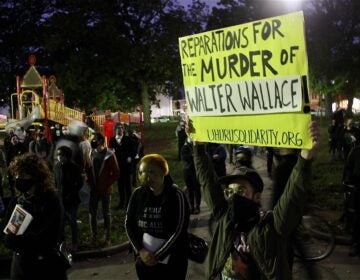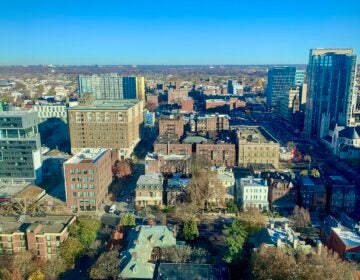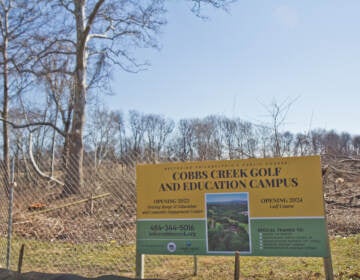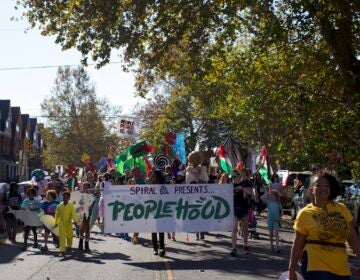Grieving Walter Wallace Jr. and seeking justice, West Philly wonders what’s next
West Philadelphians described their own efforts to de-escalate conflicts and heal their community as they mourned the police shooting of Walter Wallace Jr.
Listen 1:06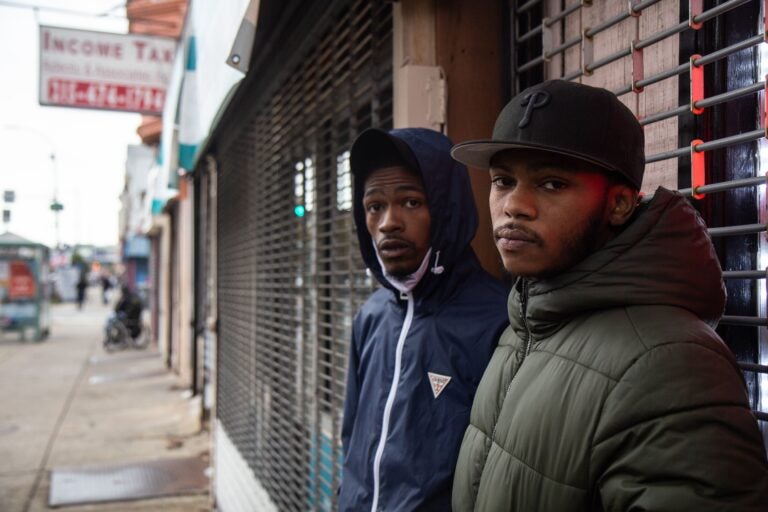
Rasheed Austin and Logan White live in West Philadelphia and said they cried when they watched witness video of Philadelphia police shooting Walter Wallace. (Kimberly Paynter/WHYY)
Steven Hall stood in front of Q and S Discount, the 52nd Street beauty supply shop where he works as a security guard and salesman. Merchandise was strewn all over the sidewalk. It was the second time in six months people had looted the store.
“I’m pissed off because this is my bread and butter,” Hall said. “Now, I am out of a job.”
The beauty supply store was damaged last in late May following protests against the police killing of George Floyd in Minnesota. The sequence of events ran the same this time, except for the name of the Black man killed by police called to the scene by a 911 request for an ambulance.
Walter Wallace Jr. was a 27-year-old West Philadelphia man struggling with mental health issues. After a video showing police officers shooting the newlywed father multiple times in front of his mother and neighbors circulated online, hundreds of protestors took to the streets marching for hours. That protest ended in a chaotic standoff with police at 52nd Street, where looting ensued. Well into Tuesday morning, people were still entering stores taking merchandise.
The events are the latest in a series that has tripped up the once-prosperous corridor of shops and businesses from making the comeback that many in the tight-knit, predominantly Black community want to see.
“What they did last night, it doesn’t make sense to me, at all,” said Hall. “Because these store owners had nothing to do with that cop shooting that young man.”
After crushing economic losses associated with the coronavirus pandemic, several stores were damaged and depleted amid that calamitous afternoon last May. That day ended with militarized police unleashing tear gas and rubber bullets throughout the neighborhood, injuring bystanders and sending noxious gas into people’s homes.
Mohammed Uddin owns two storefronts on 52nd Street. Both suffered destruction and theft during the first uprising. It cost him about $200,000 worth of merchandise, he said. The businesses were spared this time, but only after he with friends and family stood guard through the night to protect the businesses. But to see the strip under such duress again is “too much,” he said.
“It’s very frustrating,” Uddin added. “[It’s] very hard to be surviving as a business.”
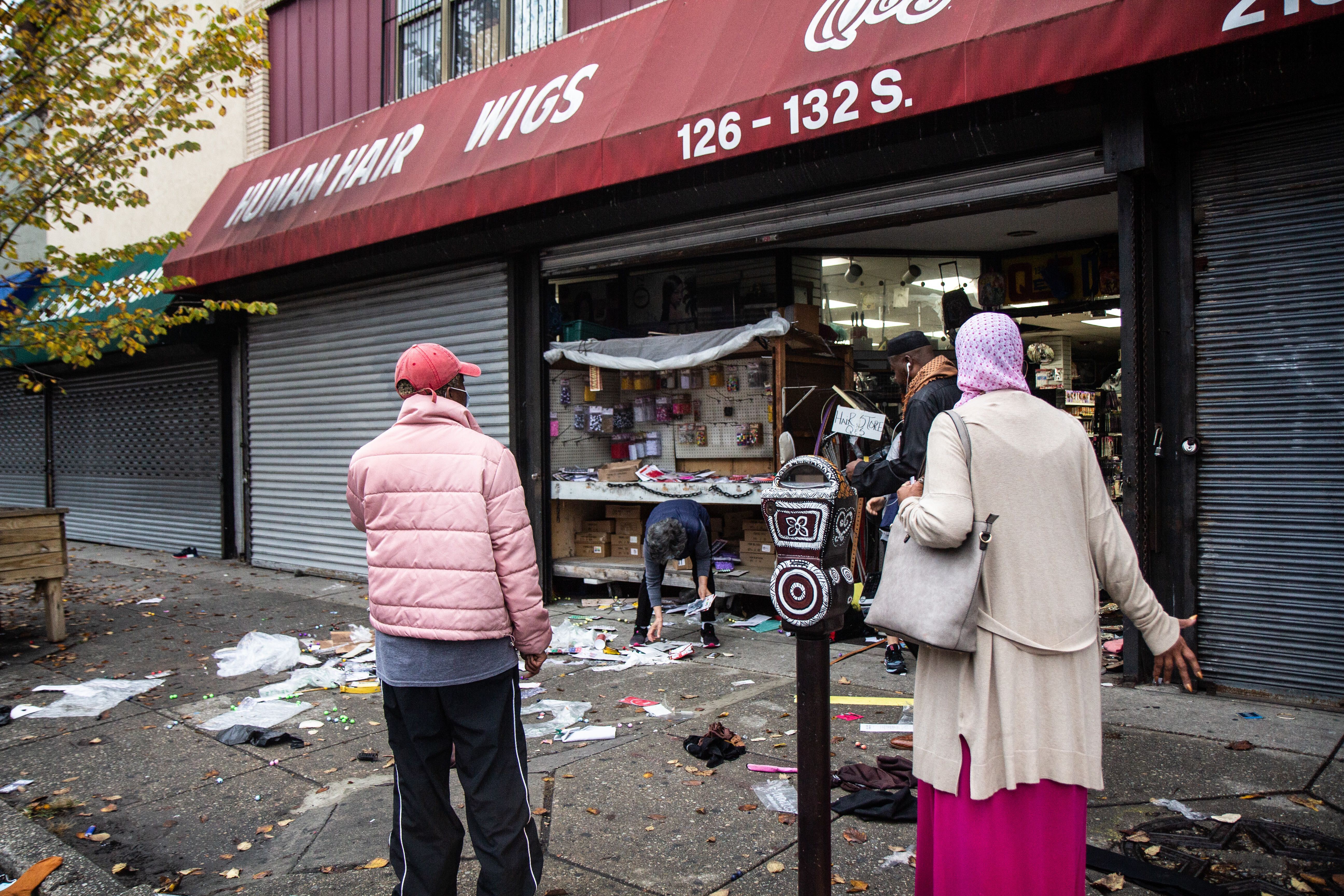
Frustration seemed to permeate the strip as people walked by damaged stores, criticizing the looting as well as the police use of force that triggered it.
Rasheed Austin of West Philadelphia said he cried over Wallace’s killing, but lamented another chaotic night on 52nd Street. Calling for a change, the 28-year-old asked “what’s next?” and called for more leadership during conflicts in the community.
“We’re better than that,” Austin said. “We need to get somebody out there … Market, Walnut Street, Chestnut and put a f—–g podium out that jawn and sit and talk. What’s up? What’s next? What are we going to do next?”
Clinton Lewis walked among neighbors on 52nd Street, observing the damage the day after, just as he had in May. He addressed the inevitability of destructive social uprisings when communities feel wronged by the state.
“There comes a time in life where enough is enough,” said Lewis, 55, who was a child during civil rights-era clashes, and a young adult when Philadelphia bombed the MOVE movement houses nearby on Osage Avenue. “We’re like a time bomb ticking right now, and all you gotta do is light the fuse.”
Della Clark, the CEO and President of The Enterprise Center, an economic development agency that works on 52nd Street, said the tragic shooting of Wallace and the clashes that have followed are symptoms of “systemic disinvestment” in neighborhoods.
“52nd Street, historically a Black business district known as West Philadelphia’s Main Street, has suffered from decades of disinvestment and continues to shine a light on the symptoms of our society-wide crisis,” Clark said. “For decades, our society has neglected minority neighborhoods all over our city and country. What is happening in West Philadelphia is a litmus test, for all of us, on how we will respond to the consequences of systemic racism and over-policing of our neighbors.”
The Enterprise Center will lend “aid to immediate responses such as clean-ups and peaceful protests, but we will need partners and investors to help build up rather than merely patch up 52nd Street,” Clark said.
Community leaders question police decision to shoot
Kendra Van de Water is the co-founder of YEAHPhilly, a nonprofit that focuses on youth empowerment and works largely in the Southwest Philadelphia area where Wallace’s life was cut short. In rec centers and parks near the block where police fatally shot him, they teach youth conflict resolution and mediation. Van de Water, a licensed social worker, says she and her YEAHPhilly partner James Aye face people with weapons “all the time.”
“There is literally no excuse for them shooting him that many times,” said Van de Water. “We de-escalate people with weapons all the time. I have never had to call the police ever. I have never had to hurt anybody ever.”
The West Philadelphia organizers announced Tuesday that they would no longer partner with Philadelphia police. In a post shared on social media, Van de Water and Aye pointed to the incident as evidence of the need for safe spaces where Black teenagers can spend time. “This is a perfect example of why we were so adamant about having our own building for our teens.” The group is currently fundraising to build a community center nearby.
30 injured police officers, 91 arrests
In a Tuesday afternoon press conference, Philadelphia Police Commissioner Danielle Outlaw offered few new details. She declined to release the names of two officers involved in the shooting, footage from their body-worn cameras, or any information about 911 calls preceding the incident.
“We’re still reviewing everything we have right now,” she said. Much of the new information offered by the department related to the chaotic night that followed the shooting. Although Outlaw said she authorized a civil unrest response in the “early evening,” footage shows a contingent of police overwhelmed by a swelling crowd. Thirty officers suffered injuries Monday night — mostly cuts and bruises sustained after clashes with protestors. However, one sergeant remains hospitalized with a broken leg after a pickup truck struck him, Outlaw said. Eight police vehicles and one medic unit were damaged, including a cruiser that was set on fire, she said.

According to Outlaw, 91 arrests were made overnight and into the morning, including three for failure to disperse, 11 for assaults on police and 76 for burglaries or looting. This number was expected to rise as several investigations were still ongoing, she said.
Mayor Jim Kenney described the unrest on 52nd Street as “further evidence of the anguish of Black and brown residents of our city who have struggled their entire lives under systemic racism.”
“I’ve lived my life as a white man, with all the privileges that brings. I cannot truly fathom the reality so many fellow Philadelphians of color have endured,” Kenney said. “The tragic incident last night shows yet again that our system fails to protect Black men.
The mayor, who has made racial equity a central focus of his administration, said that his administration continues to work on “lasting reforms” and plans to do more with the Mayor’s Office of Black Male Engagement, an office created in 2012 by former Mayor Michael Nutter.
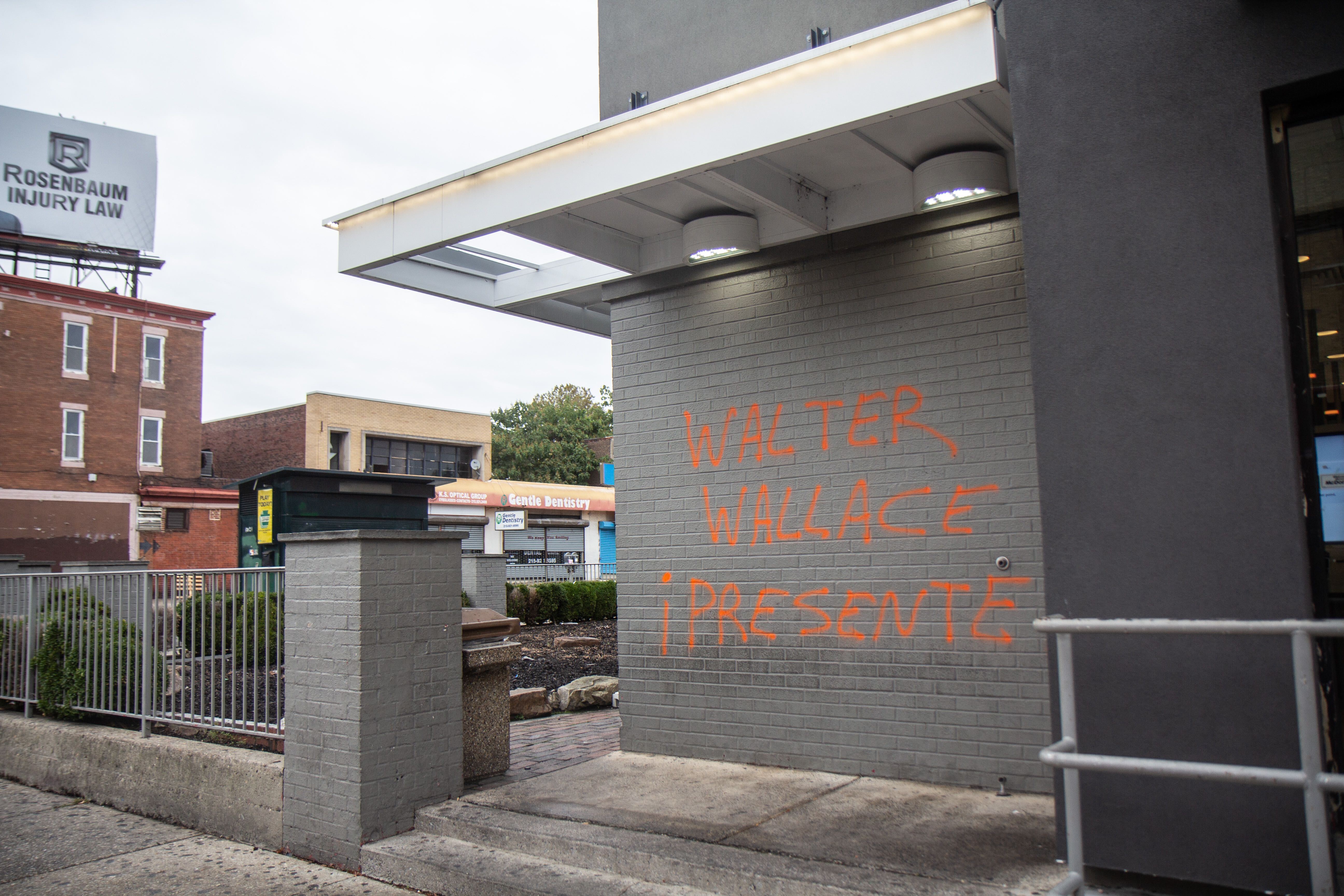
 WHYY is one of over 20 news organizations producing Broke in Philly, a collaborative reporting project on solutions to poverty and the city’s push towards economic justice. Follow us at @BrokeInPhilly.
WHYY is one of over 20 news organizations producing Broke in Philly, a collaborative reporting project on solutions to poverty and the city’s push towards economic justice. Follow us at @BrokeInPhilly.

Subscribe to PlanPhilly
WHYY is your source for fact-based, in-depth journalism and information. As a nonprofit organization, we rely on financial support from readers like you. Please give today.



